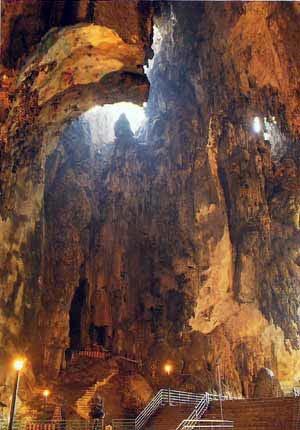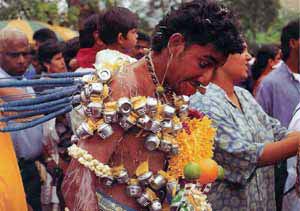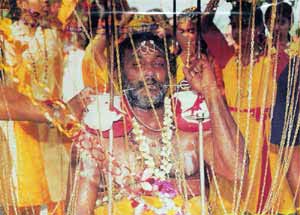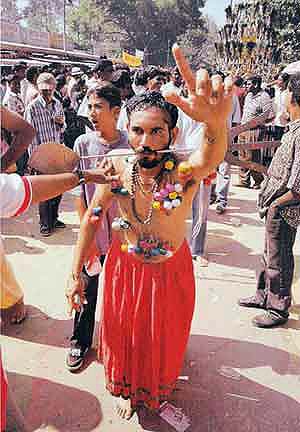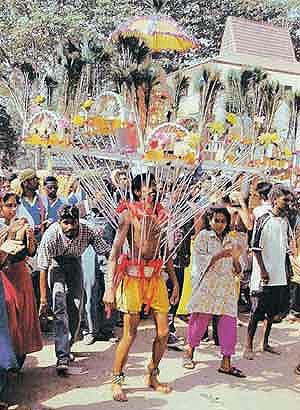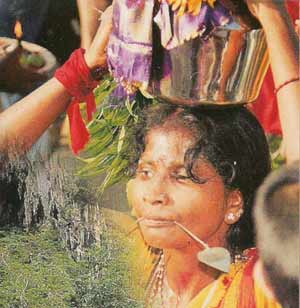
|
|||||||||
|
| |||||||||
Thai Pusam at Batu Caves, Malaysiaby Swami Guhabhaktananda, Sivananda Asramam, Batu Caves, MalaysiaThaipoosam, which falls in the month of Thai (January-February), is celebrated with intense devotion by a very large section of the people throughout Malaysia. It is celebrated on the full moon day when the constellation Pusam is on the accent. Lord Skanda is the spiritual son of Lord Siva. On this day the Lance (Vel) was given to him by his mother. The origin of Lord Skanda, the purpose of His avatara and its significance are of much importance to all seekers after truth. During the battle between the Asuras and the Devas, the later were defeated several times by the former. The devas were unable to resist the onslaught of the Asuric forces. Then, in despair, they approached Lord Siva and entreated him to give them an able leader under whose heroic lead they might obtain victory over the Asuras. They surrendered themselves completely and prayed to Lord Siva sincerely. The gracious Lord granted their request by creating mighty divine warrior, Lord Skanda, out of his own power or Achintya Sakti. This great son of Lord Siva at once assumed leadership of the celestial forces, originated them, inspired them and attacked the asuric forces. The asuras were routed and a glorious victory was gained by the Devas. Make a whole hearted surrender at the feet of the Divine even as the Devas surrender to Lord Siva. And like them pray earnestly with Bhava and sincerity. The Divine help will surely come, and in your heart will spring up the routing torrent of Divine Sakti. The Lord's grace will become manifest to you in the form of inner soul force. This is the Divine power of Jnana Sakti symbolised by the Vel which vanquish all the undivine forces that attack you on the spiritual path and emerge triumphant and victorious. Perhaps the most propitiatory rite that a devotee of Shanmuka undertakes to perform is what is known as the Kavadi. The benefits that a devotee gains from offering a kavadi to the Lord are a million fold greater than the little bit of pain that the devotee inflicts upon himself. Generally people take a vow to offer a kavadi to the Lord for the purpose of tiding over or averting a great calamity. For instance, if the devotee's son is laid up with a fatal disease, he would pray to Shanmuka to grant the boy a lease of life in return for which the devotee would take a vow to dedicate a kavadi to Him. Though this might, on the face of it might appear materialistic, a moment's reflection will reveal that it contains in it the seed for the Supreme God love. The worldly object is achieved; and the devotee offers the kavadi. After the ceremony is over, he gets so much intoxicated with love of God that his spiritual, inner chamber is opened now. This too ultimately leads to Para Bhakti. Kavadi: From the simple shape of a weighing balance or a heavy wooden stick to rest on the shoulder, to the two ends of which are tied two vessels tied at the mouth with cloth - the kavadi varies in its shape and type to the costly palanquin superstructure, profusely flower-bedecked and interwoven with peacock feathers (a feather that is of very great significance in Shanmuka worship.). In all cases the kavadi has a good many brass bells adoring it and announcing it as the Kavadi Bearer observes mauna or the vow of silence, the bell alone is eloquent of the kavadi procession. Now, the two pots hanging at either end of the kavadi might contain milk, honey, panchamirtham or other articles which the devotee has vowed to offer to Lord Shanmuka. The kavadi bearer has to observe various rules between the time he takes up the kavadi and the day of offering. He has to perform elaborate ceremonies at the time of assuming the kavadi and at the time of offering it to the Lord. He has to dress in yellow and carry a cane silver capped on both ends. The kavadi bearer's bare chest is covered with holy ash and rudraksa mala. The kavadi bearer observes celibacy. He takes sattvic food; and abstains from all types of intoxicating drinks and drugs. He continuously dwells in the thought of the Lord. Many of the kavadi bearers, especially those who do it as a sadhana, impose various sorts of self torture upon themselves. They pass a sharp, little Vel through their tongue which is made to protrude out of the mouth. Or, they pass a Vel through the cheeks. The Vel pierced through his tongue or cheeks reminds him constantly of Lord Shanmuka; it prevents him from speaking. It gives him great power of endurance. The kavadi bearer does not shave himself; he grows beard. He eats only once a day. In all cases, the kavadi procession terminates in an elaborate, colourful and inspiring ceremony. The priest chants various hymns in praise of Lord Shanmuka. Incense is burnt. Drums are beaten. Musical instruments are played. The devotee himself is in a high state of religious fervour. He dances in ecstasy. Thaipoosam is celebrated very grandly in Batu Caves. According to the press and temple authorities, 1.2 million to 1.5 million devotees throng to the temple to witness the more then 1,000 kavadis that come to the temple and also to pay their obeisance to Lord Shanmuka. The whole atmosphere is charged with the chanting of ‘Vel Vel'. May Lord Shanmuka shower His choicest blessings on His devotees is my prayer at His Lotus Feet. See also:
|
